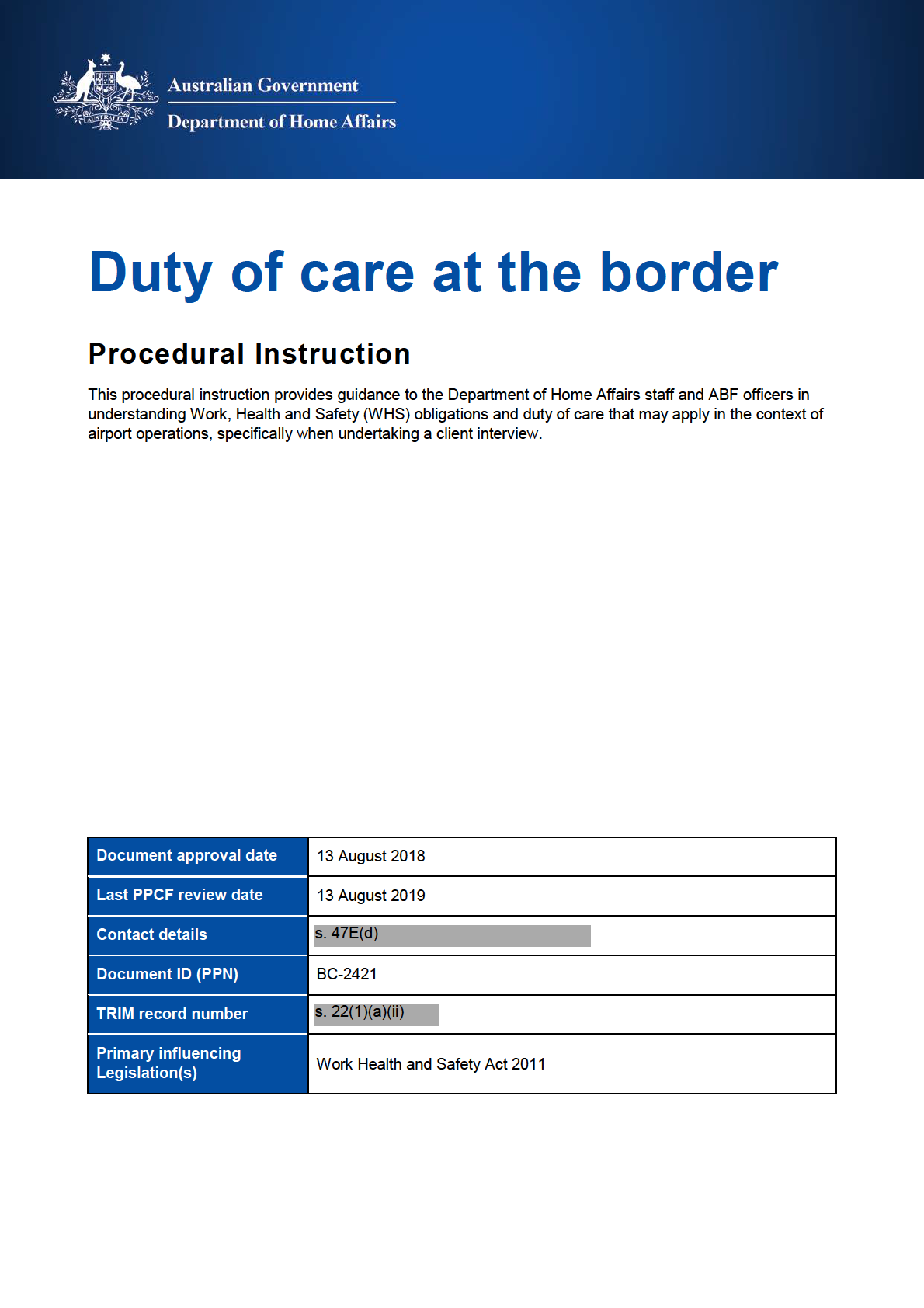



Table of Contents
Duty of care at the border
1
1.
Introduction
3
1.1. Background
3
2.
Scope
3
2.1. In Scope
3
2.2. Out of Scope
3
3.
Glossary
4
4.
Procedural Instruction
6
4.1. Work Health and Safety Act and duty of care obligations
6
4.2. Engaging with a traveller at the primary line
6
4.3. Process for interviewing a traveller
7
4.4. Work Health and Safety pursuant of the Act during an interview
7
4.5. Obligations continue until the traveller is released or transferred
8
4.6. Other matters for consideration
8
4.7. Work Health and Safety Incident report
8
5.
Accountability and responsibilities
9
6.
Statement of Expectation
9
7.
Related Framework documents
9
7.1. Policy Statement
9
7.2. Procedural Instructions
9
8.
References and legislation
10
Work Health and Safety Act 2011
10
Work Health and Safety Regulations 2011
10
9.
Consultation
10
9.1. Internal consultation
10
9.2. External consultation
10
10.
Document details
11
10.1. Document change control
11
10.2. Procedural Instruction approval
11
11.
Appendices
12
11.1. Appendix A
12
Client Monitoring Sheet
12
23TDuty of care at the border
Page
2 of
12

 1.
Introduction
1.1. Background
1.
Introduction
1.1. Background
All persons should perform their duties in accordance with Commonwealth Work Health and Safety (WHS)
laws by:
•
taking reasonable care for their health and safety
•
ensuring their acts or omissions do not adversely affect the health and safety of other persons
•
ensuring they are aware of WHS reporting requirements.
2.
Scope
2.1.
In Scope
This procedural instruction details the obligations under the
WHS Act 2011 (WHS Act) and pursuant of the
Act for Australians Border Force (ABF) officers, and other deemed workers, when dealing with travellers at
the Australian border.
This procedural instruction applies to staff in the aviation and maritime environments under the
Migration Act
1958 (Migration Act).
2.2.
Out of Scope
This procedural instruction does not apply to clearance of goods/travellers under the
Customs Act 1901 (Customs Act).
23TDuty of care at the border
Page
3 of
12
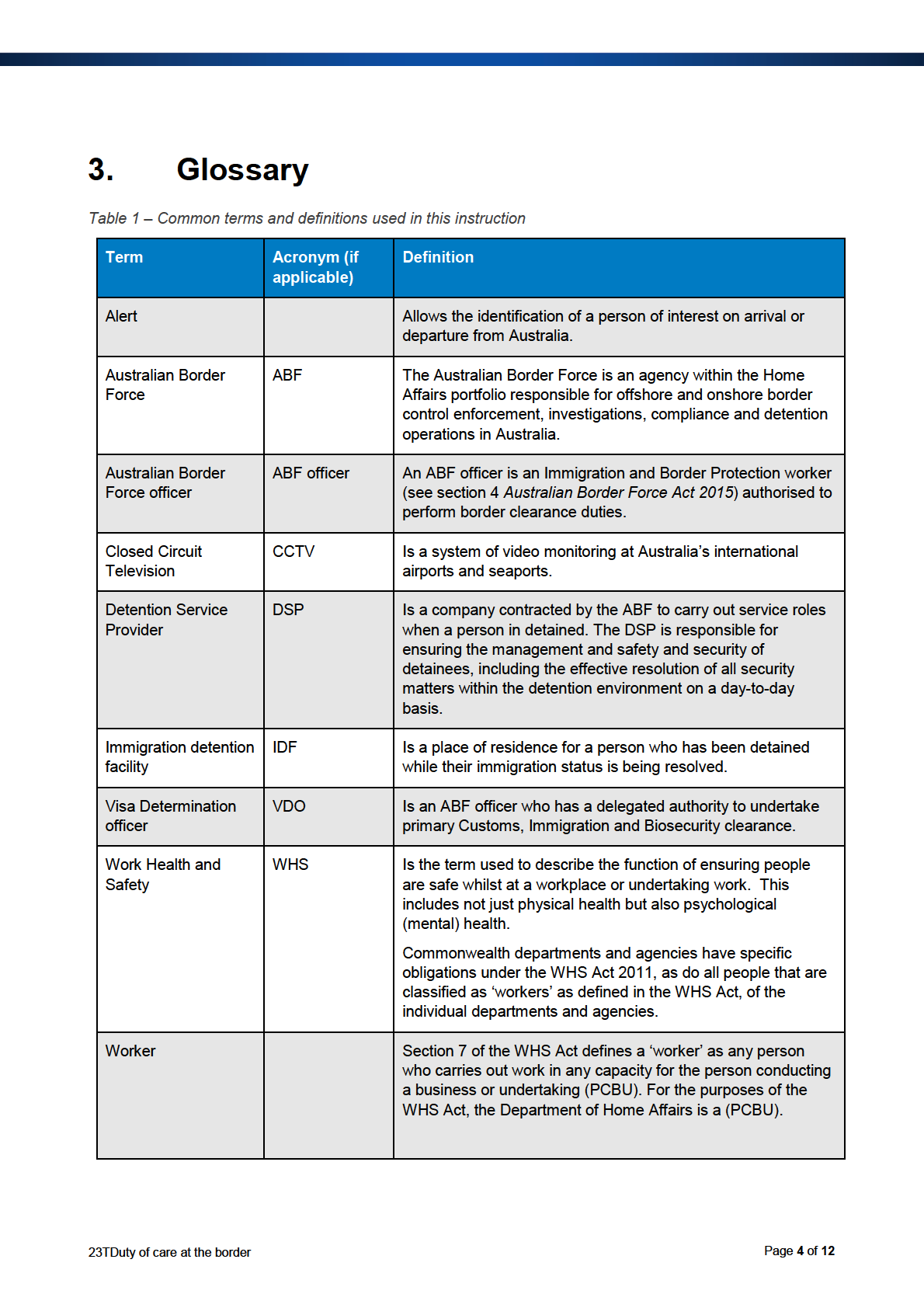

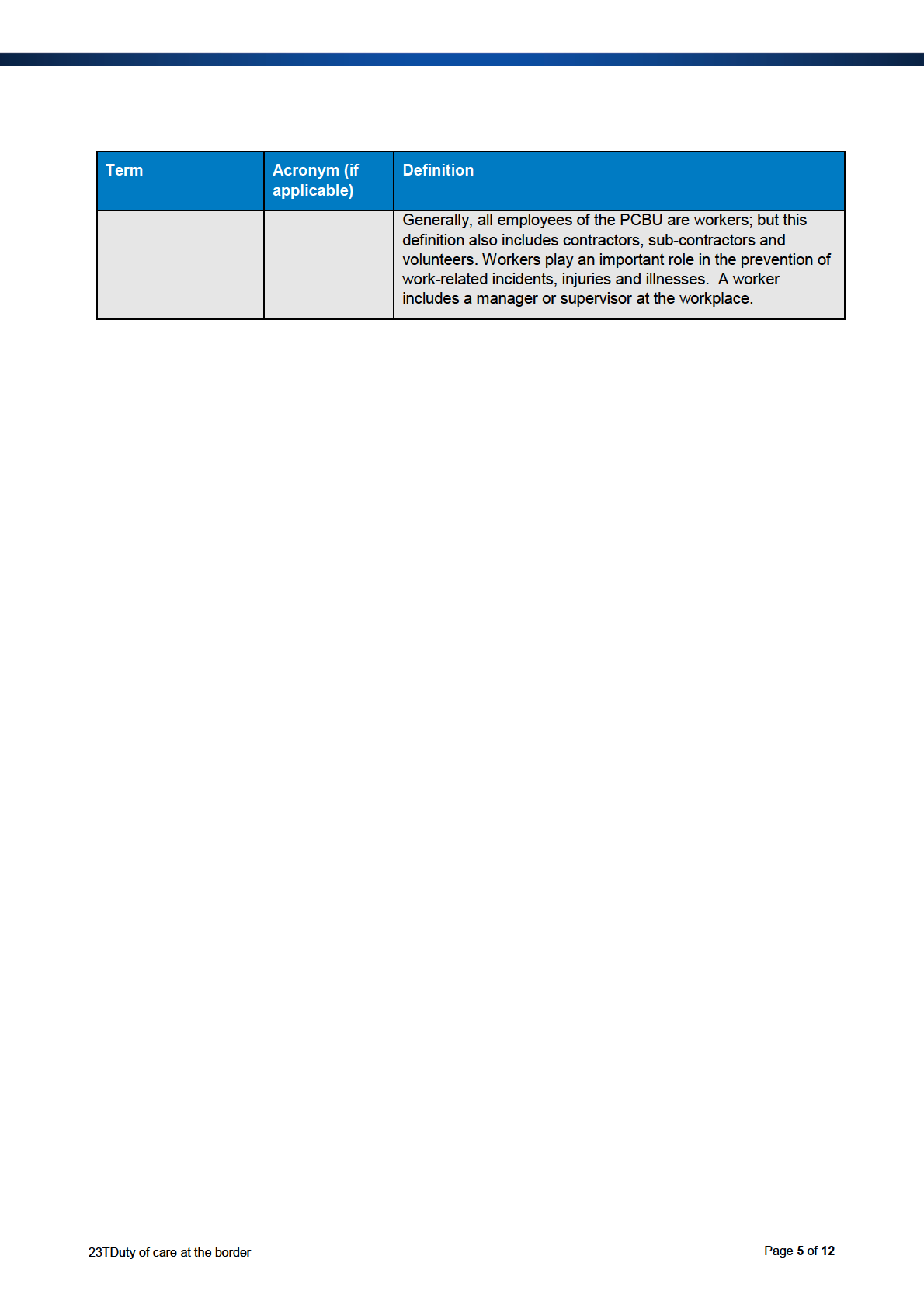


 4.
Procedural Instruction
4.1. Work Health and Safety Act and duty of care obligations
4.
Procedural Instruction
4.1. Work Health and Safety Act and duty of care obligations
For the purposes of the WHS Act the Department of Home Affairs is a person conducting a business or
undertaking (PCBU), The Department, as a PCBU, has a primary duty of care under section 19 of the WHS
Act to protect the health and safety of its workers and other persons, such as visitors, clients and detainees.
Section 7 of the WHS Act defines a ‘worker’ as any person who carries out work in any capacity for the
Department. Generally, all employees of the Department are workers; but this definition also includes
contractors, sub-contractors and volunteers. Workers play an important role in the prevention of work-related
incidents, injuries and illnesses. A worker includes a manager or supervisor at the workplace.
Section 28 of the WHS Act outlines that while at work, workers must:
•
take reasonable care for his or her own health and safety
•
take reasonable care that his or her acts or omissions do not adversely affect the health and
safety of other persons
•
comply, so far as the worker is reasonably able, with any reasonable instruction that is given by
the person conducting the business or undertaking to allow the person to comply with the WHS
Act
•
co-operate with any reasonable policy or procedure of the person conducting the business or
undertaking relating to health or safety at the workplace that has been notified to workers.
ABF officers must ensure in performing duties they take reasonable steps to meet obligations under the
WHS Act by:
•
taking reasonable care for their health and safety
•
taking reasonable care so that his or her acts or omissions do not adversely affect the health
and safety of other persons in the workplace co-operate and comply with any national policy,
procedure, direction or other reasonable instruction relating to health or safety at the workplace.
Reasonable care will be different in each circumstance. In assessing the care required, the ABF officer
should turn their mind to the individual traveller’s vulnerabilities and the control they are able to exercise over
their work activities. For example, an officer may be required to undertake different actions when conducting
an interview with an elderly, non-English speaking traveller who may suffer from health issues compared with
a young, English-speaking healthy traveller.
4.2. Engaging with a traveller at the primary line
At the primary line, s. 47E(d)
the Visa Determination officer (VDO) is to
engage the traveller in the following manner:
•
introduce themselves by name to the traveller, state they are from the ABF and advise the
traveller of the reason for the inquiry or referral
•
consider if the traveller is a minor, if so refer to Procedural Instruction: Managing minors in
immigration clearance
•
maintain confidentially by communicating discretely and if necessary relocate to a more private
area
23TDuty of care at the border
Page
6 of
12


•
maintain notes, including information gathered and traveller interactions.
4.3. Process for interviewing a traveller
If a traveller is to be formally interviewed, the VDO is to:
s. 47E(d)
4.4. Work Health and Safety pursuant of the Act during an interview
During the interview process, an ABF officer must turn their mind to their obligations under the
Work Health
and Safety Act 2011 (WHS Act) and duty of care towards travellers. The ABF officer should consider the
individual travellers position and assess what, if any vulnerabilities the traveller may have. In doing so, the
ABF officer should consider:
•
if the traveller appears seriously ill, follow local procedures and organise an ambulance
immediately
s. 47E(d)
•
provide water, meals and non-alcoholic beverages as required
•
provide access to toilet facilities as required – if there is a suspicion of internal substance
concealment refer to
Procedural Instruction: Controlled toilets
•
update the Client Monitoring sheet (Appendix A).
23TDuty of care at the border
Page
7 of
12


ABF officers should be conscious that this is not an exhaustive list. The ABF officer should consider the
situation, and raise concerns with their supervisor if there appears to be a risk.
4.5. Obligations continue until the traveller is released or transferred
When a traveller is refused immigration clearance and is awaiting removal or transfer to an immigration
detention facility (IDF), the ABF officer should continue to take reasonable steps to ensure the health and
safety of the traveller.
s. 47E(d)
ABF officers should consider what, if any, other reasonable steps may be taken to ensure the health and
safety of the traveller.
4.6. Other matters for consideration
An ABF officer should:
•
ensure they have a clear understanding of their obligations under the WHS Act, WHS
regulations and of what their responsibilities are under all relevant directions, policies,
procedural instructions and other published departmental information e.g. mandatory training
•
comply with directions, policies, procedural instructions and other published departmental
information
•
co-operate with the implementation of any new safety management systems
•
co-operate with the implementation of risk management processes
•
report identified maintenance/infrastructure issues
•
ensuring efficient and timely reporting of WHS incidents and other issues that have the potential
to affect health and safety
•
not engage in conduct that exposes any individual to serious injury, illness or death.
4.7. Work Health and Safety Incident report
A Work Health and Safety (WHS) incident report form must be completed in EasySAP immediately following
all work-related safety incidents including:
•
incidents where a person(s) is injured or ill;
•
‘near miss’ incidents, where an incident occurred and there was a possibility of a person
sustaining an injury or illness; and
•
the death of a person.
An incident report must be completed irrespective of whether the incident involves ABF employees,
contractors, subcontractors, volunteers, or any other person at the workplace such as a traveller or visitor.
For more information, refer to
Procedural Instruction: WHS incident management and reporting.
23TDuty of care at the border
Page
8 of
12

 5.
Accountability and responsibilities
5.
Accountability and responsibilities
If ABF officers require clarification or assistance in regards to this procedure, they should contact the
Traveller Operational Policy Section by email s. 47E(d)
s. 47E(
or telephone:
AEST.
The Superintendent, Traveller Operational Policy Section has responsibility for the preparation and
dissemination of this Procedural Instruction in regards to operational policy and programme management of
border clearance activities for air and sea travellers, under the Customs Act and Migration Act.
The Director, Traveller Policy Section has responsibility for preparation and dissemination of the Policy
Statement in relation to this Procedural Instruction.
6.
Statement of Expectation
This Procedural Instruction under the PPCF sets out guidance and directions to workers on how to
implement the Department’s policy.
It is expected that all workers who are subject to this Procedural Instruction will have due regard to it and will
only depart from it if:
a) the departure is reasonable and justified in the circumstances;
b) all risks have been considered; and
c)
approval has been sought and responsibility accepted for documenting the justification for
the decision.
Workers are required to comply with all reasonable and lawful directions contained in this Procedural
Instruction. Failure to comply with a direction may be considered a breach of the Australian Public Service
Code of Conduct (for APS employees) or the
Professional Standards Secretary’s Direction under section 55
of the
Australian Border Force Act 2015 (for non-APS employees).
All records created as a result of this procedure must be managed in accordance with the Records
Management Policy Statement. Records created as a result of this policy/procedure must be saved in TRIM
RM8 or an approved business system.
7.
Related Framework documents
This instruction must be read with:
7.1. Policy Statement
[HR-1230]
Work Health and Safety Governance Arrangements.
7.2. Procedural Instructions
[BC-2676]
Managing minors in immigration clearance.
[BC-683]
Controlled toilets.
23TDuty of care at the border
Page
9 of
12

 8.
References and legislation
Work Health and Safety Act 2011
8.
References and legislation
Work Health and Safety Act 2011
This Act sets out the primary requirements relating to the health, safety and welfare of persons at work and
follows:
•
section 28 outlines the duty of care.
Work Health and Safety Regulations 2011
The WHS Regulations complement and support the general duties under the WHS Act by setting out
mandatory obligations on specific matters.
9.
Consultation
9.1.
Internal consultation
The following internal stakeholders have been consulted in the development of this Procedural Instruction:
•
Traveller Branch, Traveller Policy Section
•
FOI Privacy and Records Management Branch, Records Management Section
•
Integrity Security and Assurance Division, Integrity and Professional Standards Branch
•
People Management Branch, Workforce Health and Safety Section
•
Civil Commercial and Employment Law Branch, Civil Litigation and Compensation Section.
9.2.
External consultation
No external consultation.
23TDuty of care at the border
Page
10 of
12
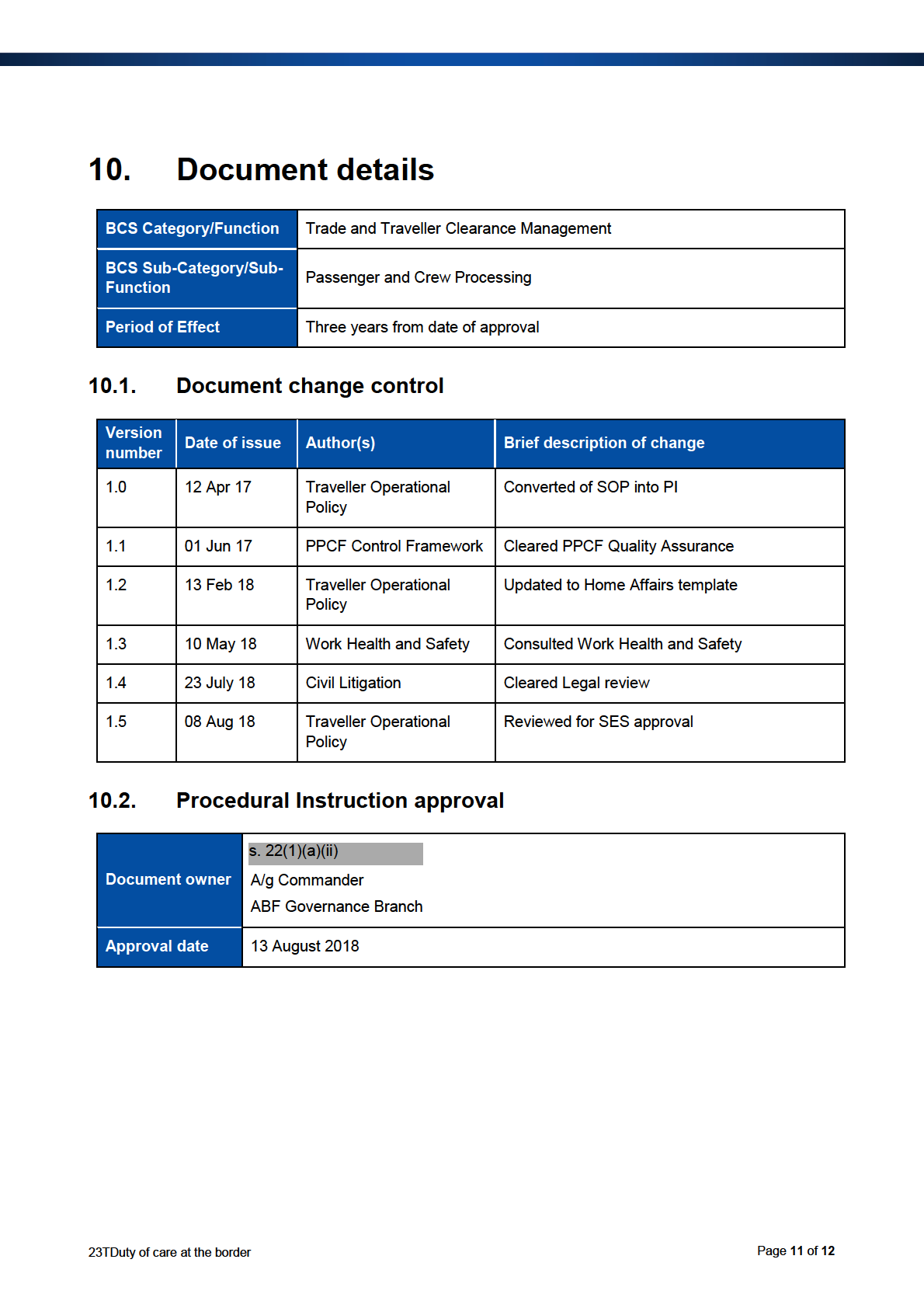


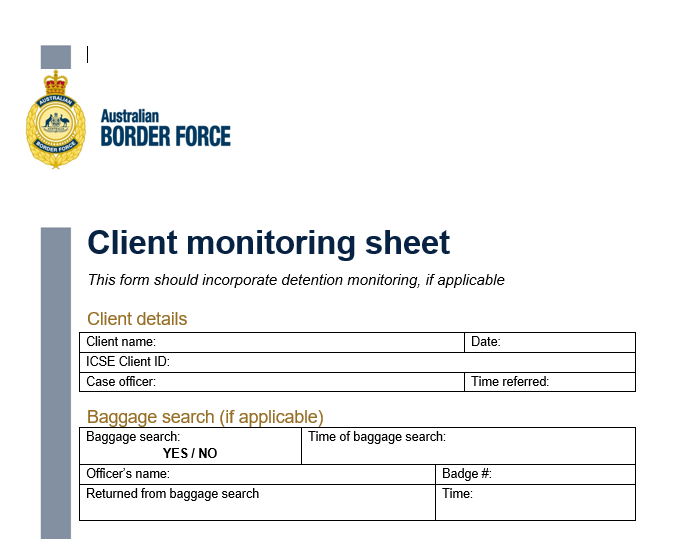
 11.
Appendices
11.1. Appendix A
Client Monitoring Sheet
11.
Appendices
11.1. Appendix A
Client Monitoring Sheet
Available in TRIM s. 22(1)(a)(ii)
23TDuty of care at the border
Page
12 of
12
























